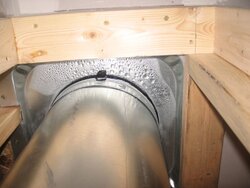This is my first post here, so please bear with me. I have searched the forums, but cannot find a specific answer, so I am hoping some experts will chime in here, as I am not getting much help from my dealer.
I recently purchased a Heat N Glo RH36 Wood Burning Fireplace to install during new construction. It came with the double wall 10 1/2" chimney, and this is where the problem started. After installing it, I get water running down the chimney into the house when the temp is just right. To give a little background, the insert is in the basement, and then the chimney goes up through a chase into the attic, through the insulation shield (no chase in attic or on roof). When it gets cold (it was -15 here today), I get condensation on the warm side of the firestop at the attic. I also climbed into the attic and could not believe the frost just above the insulation line. Upon further inspection it looks like to me that frost forms on the inside of the insulation shield (they want 2" clearance between the shield and the pipe). Anyway, the frost forms, then melts when the temp is right and water runs down into the walls. I also get alot of ice buildup on the termination cap, and I feel that the warm air that is in between the double wall pipe goes up, melts the ice and the water runs down the inside of the outer wall, finds a seam to sneak through and then ends up on the top of the fireplace. I guess you could say this is a 2 part problem.
Anyway, my local dealer is not much help, and I am hoping I can find somewhat of an answer before I decide to just rip it out. It is really putting a damper in my new construction. I was told that building a chase around the whole chimney would help, but wouldn't the cold air still get in the outer wall of the chimney through the top?
Any help or suggestions is GREATLY appreciated.
I recently purchased a Heat N Glo RH36 Wood Burning Fireplace to install during new construction. It came with the double wall 10 1/2" chimney, and this is where the problem started. After installing it, I get water running down the chimney into the house when the temp is just right. To give a little background, the insert is in the basement, and then the chimney goes up through a chase into the attic, through the insulation shield (no chase in attic or on roof). When it gets cold (it was -15 here today), I get condensation on the warm side of the firestop at the attic. I also climbed into the attic and could not believe the frost just above the insulation line. Upon further inspection it looks like to me that frost forms on the inside of the insulation shield (they want 2" clearance between the shield and the pipe). Anyway, the frost forms, then melts when the temp is right and water runs down into the walls. I also get alot of ice buildup on the termination cap, and I feel that the warm air that is in between the double wall pipe goes up, melts the ice and the water runs down the inside of the outer wall, finds a seam to sneak through and then ends up on the top of the fireplace. I guess you could say this is a 2 part problem.
Anyway, my local dealer is not much help, and I am hoping I can find somewhat of an answer before I decide to just rip it out. It is really putting a damper in my new construction. I was told that building a chase around the whole chimney would help, but wouldn't the cold air still get in the outer wall of the chimney through the top?
Any help or suggestions is GREATLY appreciated.


